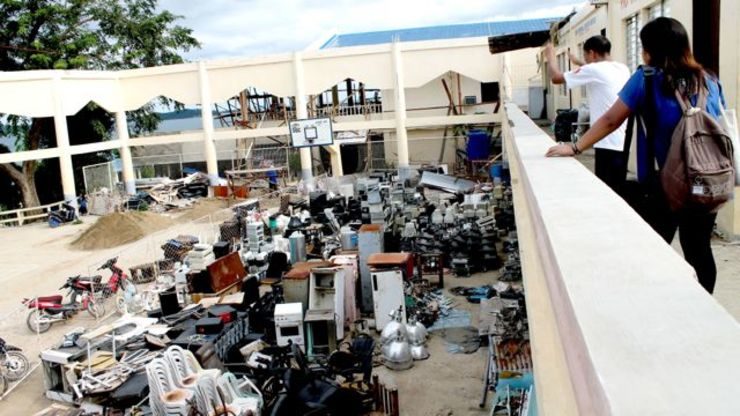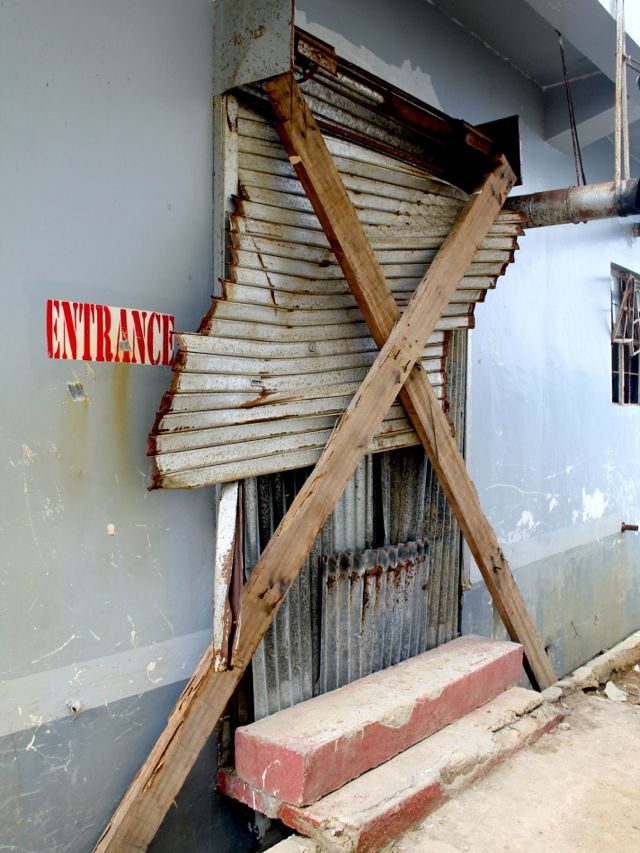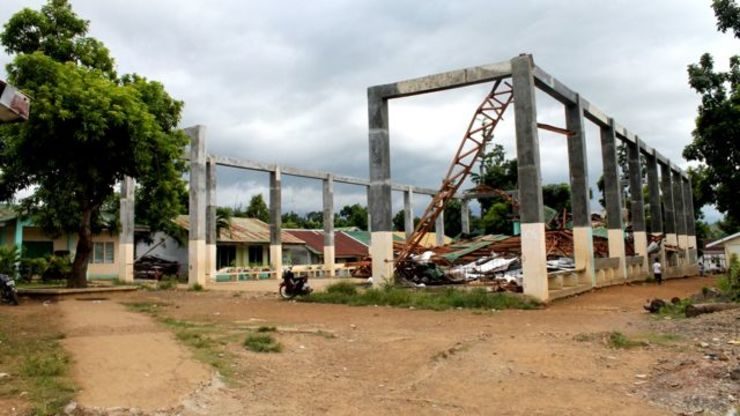SUMMARY
This is AI generated summarization, which may have errors. For context, always refer to the full article.

ILOILO, Philippines – In a 1×1 meter, 6-foot tall storage room, Sir Alfred (not his real name) could not imagine how 30 people were able to fit inside in order to survive Yolanda at Northern Iloilo Polytechnic State College (NIPSC) in Estancia, Northern Iloilo last November 8, 2013.
In his 23 years of service to the institution, never has he seen a pump boat smashing inside one classroom in the school, destroying the walls and leaving it with broken armchairs, smashed glass windows, and debris.
A day after, the entire province of Iloilo was placed under a state of calamity. A number of towns in the 5th district – Estancia, Carles, Ajuy, Barotac Viejo, Concepcion, Batad, San Dionisio, San Rafael, and Balasan – were damaged by Super Typhoon Yolanda (Haiyan).
With the death toll from the super howler continuously rising at the height of rescue operations, President Benigno Aquino III declared a state of national calamity to hasten the rescue efforts of the government and thus, rehabilitate the provinces affected by Yolanda.
Several reports said that Malacañang had already turned over relief operations to local government units so that the national government can begin to focus on rehabilitation and thus, different agencies and private sectors worked hand-in-hand in order to bring relief operations to affected areas of Iloilo.
Ten months after Yolanda left a swath of destruction, are there improvements in the schools of northern Iloilo?

Painting the roof green
At NIPSC, students wearing their new uniforms for academic year 2014-2015 were welcomed by layers of dismantled computers, broken refrigerators and dispensers, a variety of dilapidated chairs, and useless typewriters in what used to be a covered gym. All these were end products of Yolanda, after the typhoon damaged their computer laboratories. Their Science laboratory also need a major rehabilitation. The classrooms were piled up with broken wooden armchairs. The doors were sealed with heavy logs and nails.
Even the oldest tree in the school succumbed to Yolanda’s rampaging winds, just like the uprooted coconut tree that smashed into the window of their welding shop. The 4-feet cement barrier facing the shoreline was toppled by the strong waves at the height of the storm, and as the sun started to shine the day after, school officials found cold bodies piled up among the flower boxes. Until now, the barriers are untouched and the classrooms still empty.
On the other hand, 60% of the school has already been repaired. The storm surge left the school in tatters. It destroyed the facilities and building, but not the school’s and its students’ dreams.

Hiding behind the rusty metal snake
After traveling for 4 hours by bus, we reached Carles Central Elementary School. It was already 1 pm and some pupils were still outside their classrooms playing in the corridors. The pupils did not mind the flimsy wooden walls that may injure them with one wrong move.
While the children were playing, the carpenters as well seemed to have fun painting green the newly constructed roof at the next building. Donated tents have been put up, but most of the classes were held inside the tarpaulin-covered rooms.
Meanwhile, near the entrance of the Estancia Central Elementary School, a classroom built with 4 plywood walls, a number of white mono block chairs and an aging blackboard welcomed us. Meters away from that room is the field where 40 pupils endure the scorching heat inside a tent classroom.
At the right side of the field, the beams of their covered gym were dissected into pieces by the typhoon’s strength, turning it into a rusty snake-like scrap. We went closer to take photos of the snake-like structure and to our surprise, near the mouth of the “snake” were a group of children patiently listening to their teacher. The stage of their gym served as their classroom. Looking at their situation, a slight earthquake could crush them.
After their classes, they hold on to their blue bags, donated by the United Nations Children’s Fund (UNICEF).
Sparkles within darkness
It was not summer but the students of Ajuy National High School were tanned; no trees hindered the sun from burning their skin. Their eyes sparkled as they stared upwards to the skies, their classrooms roofless. The super howler destroyed rows of classrooms and intact rooms could not reach 10. Five students were taking down notes when we passed by their area.
When we looked up, we were shocked to find out that the roof was only a long sheet of blue Gina cloth. Thin sheets of cloth and pieces of lumber were constructed to make a room for one class. We wonder what happens when it rains or when the heat is too much to bear. It certainly would be very inconvenient and not conducive for learning.
Despite all of these
Across the rows of classrooms, a new building is being constructed. The carpenters endure the heat of the sun while mixing cement with water and fine sand. The students stared at the workers, excited to set foot on the new building.
On our way home, we passed by a school with three UNICEF tents situated in the front lawn of the school. By the window, we saw the children racing out of the tents with their classmates, wearing their relief clothes and worn out slippers and carrying with them their oversized bags. Precious, post-Yolanda smiles were etched on their carefree faces.
Ten months have passed. Some schools have improvements, some have less, and some have none. How long will the schools endure the wrath of Yolanda? – Rappler.com
(The writers and photographer are volunteers for the Typhoon Yolanda Story Hub Visayas, a citizen journalism portal created on November 13, 2013, by veteran journalists, student writers, mobile journalists, and photographers based in Iloilo City. The Hub delivers reports from across the Panay Island, especially the severely damaged and minimally covered northern Iloilo and the provinces of Antique, Capiz, and Aklan.)
Add a comment
How does this make you feel?
There are no comments yet. Add your comment to start the conversation.